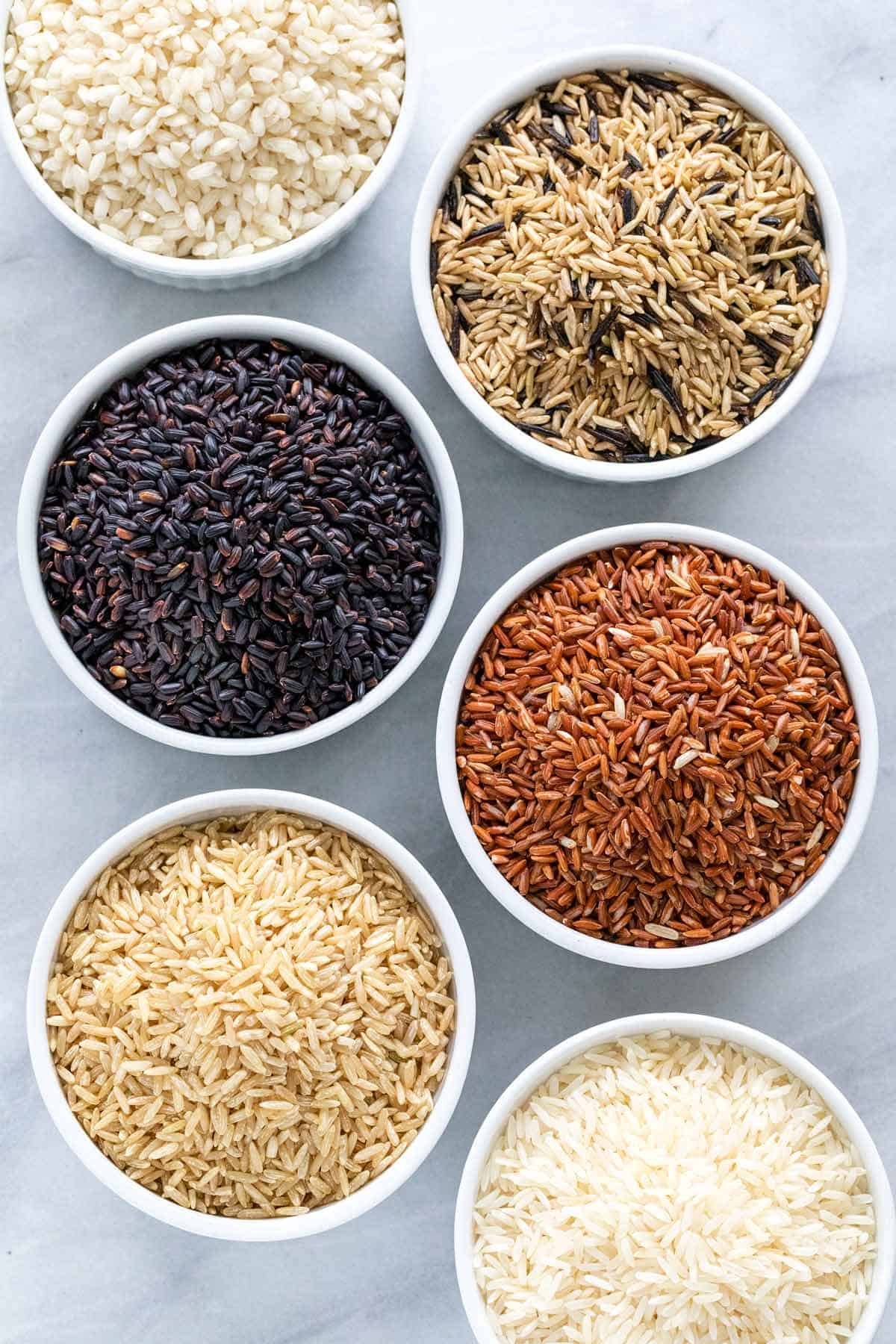Rice is one of the three most consumed cereals in the world, the other two being corn and wheat. Its cultivation began in China during the year 5000 BC, then it spread throughout Asia and during the year 800 BC it reached Europe, its starting point for the rest of the planet. There are more than 10,000 varieties of rice in the world (some say there are even 120,000 but not cataloged) and they all come from the same Orzo sativa species and its India and Japonica subspecies. However, each variety contains more or less starch of a certain type (amylose or amylopectin). The difference between one and the other are: culinary use, cooking times, cooking methods and other details.
Well, we want to tell you everything about the types of rice: how they are classified (according to their shape, organoleptic properties and processing), their main characteristics, culinary uses and other aspects. Very useful information for you to know in detail the different races that exist!
Types of rice according to its shape
If we think about the botanical classification, we find two types of rice: Indian and Japanese. The India is characterized by having long, fine and firm grains, while the Japonica is distinguished by thick and short grains. Once differentiated, we can summarize the types of rice to cook according to its shape in three:
Length
In this group we classify the following types of rice: basmati rice, jasmine rice, ferine rice, among others. To better recognize them, review their characteristics below:
- Starch percentage. Contains 22% amyloses in its total composition. For this reason, after cooking it maintains its shape.
- Texture after cooking. Its grains are loose and firm.
- Culinary uses. It is used for salads and Asian cuisine dishes.
Shorts
In this other group, the following types of rice stand out: Arborio, vial one Nano, among others. Generally, short rice has a spherical grain and also has the following characteristics:
- Starch percentage. They contain more amylopectin (this has a binding effect), and less amylose (this provides firmness).
- Texture after cooking. The grains commonly adhere easily to each other, creating a compact texture after being exposed to room temperature.
- Culinary uses. Due to its properties, this rice is among the favorites to prepare sushi. And when it comes to risottos, the Arborio and tell vial one Nano work specifically.
Medium
In the last group we have the following types of rice: carnaroli, bomb, among others. If you want to differentiate them from the previous ones, check their characteristics below:
- Starch percentage. This type of rice grain has 15% amylose in its composition.
- Texture after cooking. During cooking it absorbs liquids well without going over or breaking. At the end, a soft and somewhat sticky grain is obtained.
- Culinary uses. Bombay rice is used in paellas, baked rice, sticky rice, rice pudding and there are those who use it in sushi. While carnaroli is used in risottos. This type of grain is preferred by kitchen professionals, especially rice masters.
Types of rice according to their organoleptic properties
Rice is also classified according to its characteristics or organoleptic properties (color, aroma or texture), in this way, its attributes are better used according to the needs of the recipe. In this case, the types of rice according to their organoleptic properties are the following:
Aromatic rice
Long-grain rice varieties are usually very aromatic once cooked. In this group, jasmine rice, purple jasmine rice, Thai rice and basmati stand out. These kinds of rice are widely used in Indian and Turkish food (especially to prepare rice pilaf). Thai rice has a flavor similar to roasted nuts or the aroma of popcorn, while basmati and jasmine rice give off an aroma of popcorn or freshly baked bread. Lastly, purple jasmine rice smells precisely like jasmine flower.
Glutinous rice
Starch is made up of: amylose and amylopectin. The percentages of one and the other will define the organoleptic properties of the rice grain once cooked. We emphasize that glutinous rice has a greater amount of amylopectin and little amylose; the former is responsible for providing a glutinous and sticky texture. Glutinous rice is widely used in Asian cuisine, especially in sweet dishes and sushi.
Pigmented rice
These are characterized by giving a visual and more attractive touch to the dishes once cooked. Likewise, many of them are integral, therefore, depending on the color, we will obtain information about their phytonutrients. Among the colors that you can find and their equivalents in the varieties of rice, the following can be distinguished:
- Yellow or amber rice: Parboiled rice or golden rice reaches its golden color after going through a vaporization process in which it preserves its shell. This type of rice is characterized by being a fluffy and loose grain. Also, it does not absorb as much fat as other varieties after cooking.
- Red rice: This brown rice is considered one of the most exotic varieties. Phytonutrients called anthocyanins are located in the bran and in the peel. Once cooked, its flavor is reminiscent of nuts, especially walnuts. It is served as a side dish, in salads or risottos or depending on the variety. Red rice has many variants including: medium grain, long grain, more starchy, among others. Some well-known are Camargo, Bhutan and Thai.
- Purple rice: Purple jasmine rice comes from the cloudy peaks of the Himalayas. It stands out among other varieties for being the only typology that concentrates an amount of protein. This brown rice is characterized by its jasmine aroma after cooking, and also by its nutty flavor.
- Black rice: Veneer rice is a type of brown rice that can be prepared alone, in a salad and sautéed with fish or shellfish. Its color changes from black to purple (or purple), once cooked. On the other hand, wild rice (indigenous or wild rice) also deserves mention for its dark color (without becoming black), although it is not rice itself, but a very similar aquatic plant…
Types of rice according to their processing
Once the rice is harvested, it is subjected to certain forms of processing; in this way other types of rice for cooking arise: brown, parboiled, white and precooked rice. Below, you can see a list of types of rice according to their processing:
- Brown rice (cargo, brown or brown rice). This is defined as any variety of rice that has only had the outer shell or inedible glume removed. However, it preserves the whole germ with the layer of bran that surrounds it and this gives it its brown color. In that first layer, the grain stores a large part of its nutritional contribution (especially minerals) and also the fiber. Brown rice can be used in almost any type of recipe, but it requires a longer cooking time.
- It is a process of humid cooking and subsequent drying of the rice, in which the shell is preserved and a good part of the starch is eliminated. This technique allows keeping most of the vitamins and minerals of the rice (unlike white rice). From this procedure, the so-called parabolized (vaporized) rice or golden rice arises, which stands out for the following characteristics: it is golden in color and after cooking, it feels spongy, loose and does not absorb as much fat or water as, for example, other varieties. For this reason, it holds up well if you reheat it.
- White rice. These are the varieties of rice that have had their outer cover (hull) removed, and also the germ (the essential oils and amino acids are there), that is, it has been polished and only the endosperm remains, which is mainly made up of starch. And what is the purpose of this procedure? Well, extend the life of the rice, because by removing its natural oils, it takes longer to deteriorate. All this refining process is done dry, however, in some countries, before cleaning and brazing, they cook the rice slightly (a short steaming) to make the job easier. Consequently, white rice is a food with practically no calories or very low levels, for this reason, many manufacturers enrich it.
- Precooked rice. It consists of a heat treatment that facilitates and reduces the subsequent cooking time, that is, the consumer’s cooking time.
Types of rice for sushi
The traditional rice to prepare sushi originates from Japan, its type is called japonica and from this, a large number of varieties arise. Currently, this type of rice is also grown in Italy, the United States, Spain and other countries. The best substitutes for Japanese rice are medium grain Spanish rice.
Although japonica rice has many uses, it is often used extensively in the preparation of sushi. Among its characteristics, the short and rounded shape of its grains stand out, its shine after cooking (if it is a refined type), its firm texture, but not hard (after cooking) and its high starch content. Although we must clarify that it is not just any type of starch, it is mainly amylopectin, the characteristic starch of binder rice, a substance that after cooking provides that sticky but firm texture.
Among the many brands and varieties of Japanese rice, the best types of rice for sushi are:
- Minor: has round and short grain. It is grown in Spain, in the Ebro Delta.
- Hark: Its grain is longer and it comes from Italy.
- Fuji Mai: presents medium long grain. This Spanish variety is grown on the same site as the Minor.
Tip: There are japonica rice crosses: japonica (jasmine and japonica) and japonica black rice (japonica and Thai).
Types of rice for paella
The best rice for paella (and baked rice) is the medium grain, whose length is between 5 and 6 mm. Of this type of grain, the best varieties are those with denomination of origin, located in places with a long tradition in the preparation of paella. In this way, among the best types of rice for paella, the following varieties qualify:
- Rice bomb In Spain there are three races with denomination: Valencia, Dental del Ebro and Calasparra. And in each of these places the variety called Bombay rice is grown, which is characterized by its round grain. This grain is ideal for paellas, as it absorbs a greater amount of broth and thus better retains the flavors without losing its shape (loose grain).
- Barilla x Solana. This rice is a hybrid between both varieties and therefore its name; it is characterized by a round grain and is produced under the Calasparra denomination of origin. It is very similar to Bombay rice, although unlike Bombay rice, its price is much more accessible and its cultivation is more resistant. For paella it works very well, as it can withstand cooking and maintains its shape, but it does not retain as much flavor as other varieties. For this reason, it is recommended for vegetable paellas, which do not need such accentuated flavors.
- Bahia or Sonia rice. This variety absorbs flavors very well, but its internal and external humidity provides a grain that is difficult to separate (because it has more amylopectin), with little resistance in terms of cooking. Also, it can be easily passed.
- Crystalline semi-long rice. It shares similarities with bomb rice, but absorbs less moisture (broth). In compensation, it is looser and does not lose its shape.
- Reverence rice. This rice from China is very special and is classified as gourmet due to its organoleptic characteristics: its black color before cooking, its purple color after cooking, its crunchy texture and its aroma of dried fruit. It is used to prepare black paella or black rice without the need to use squid or cuttlefish ink.
- Alfieri rice. This variety has similar characteristics to Bombay and Sonia (Bahía) rice, and uses similar cooking times.
Tip: products of origin means that they have been grown in certain geographies, places with unique characteristics.



